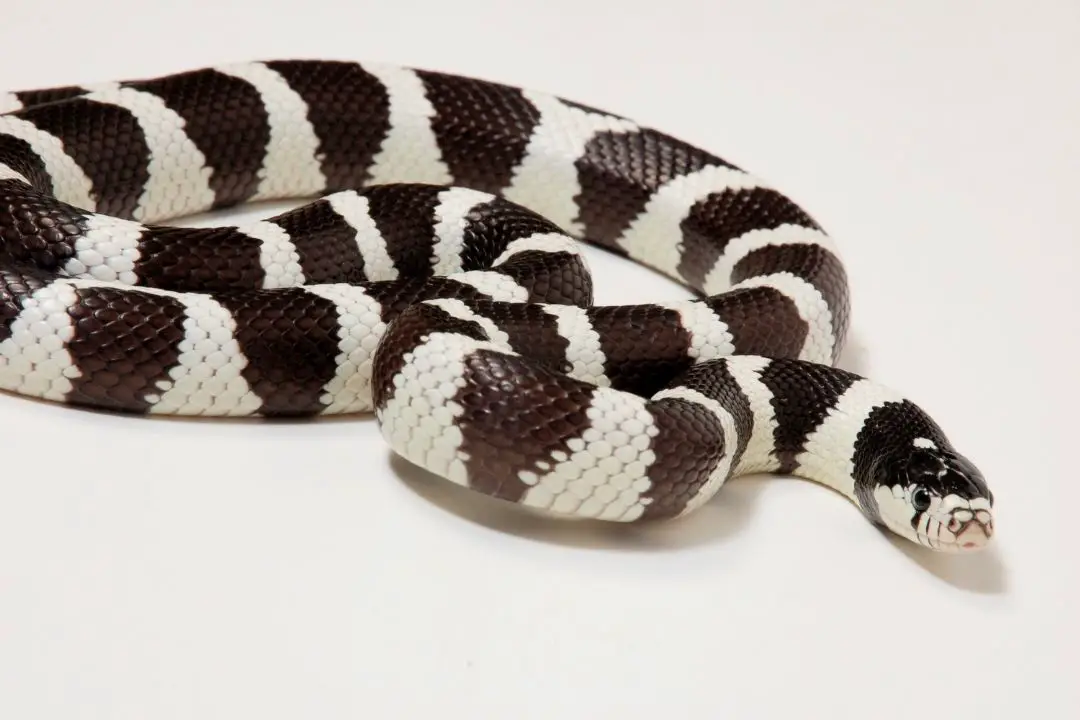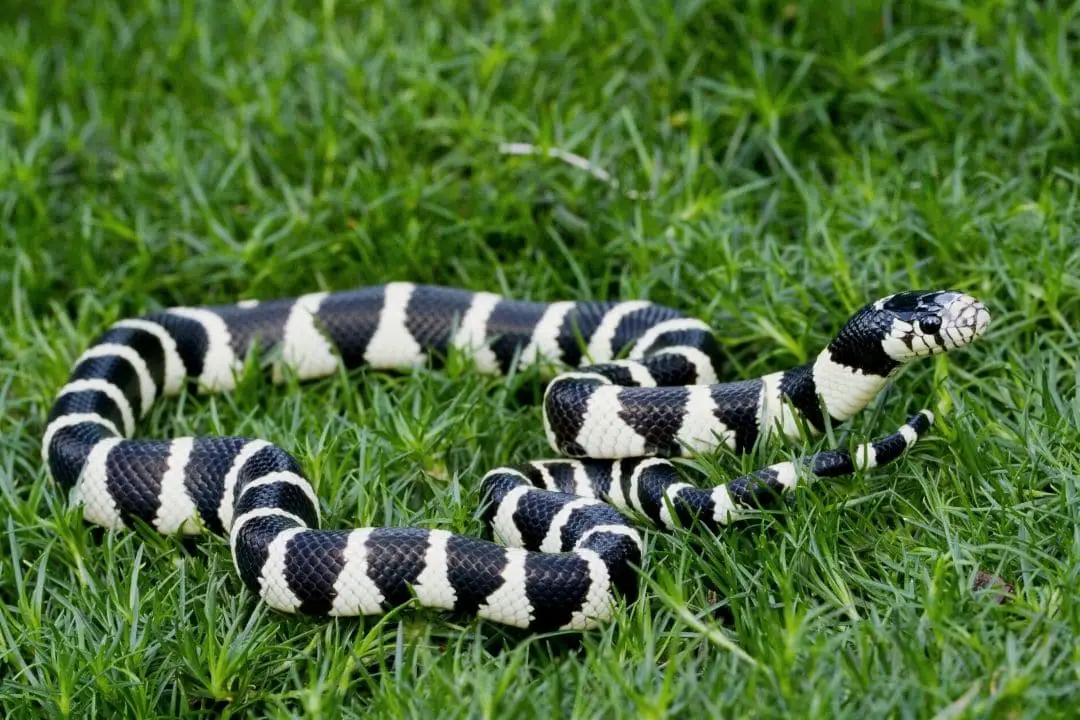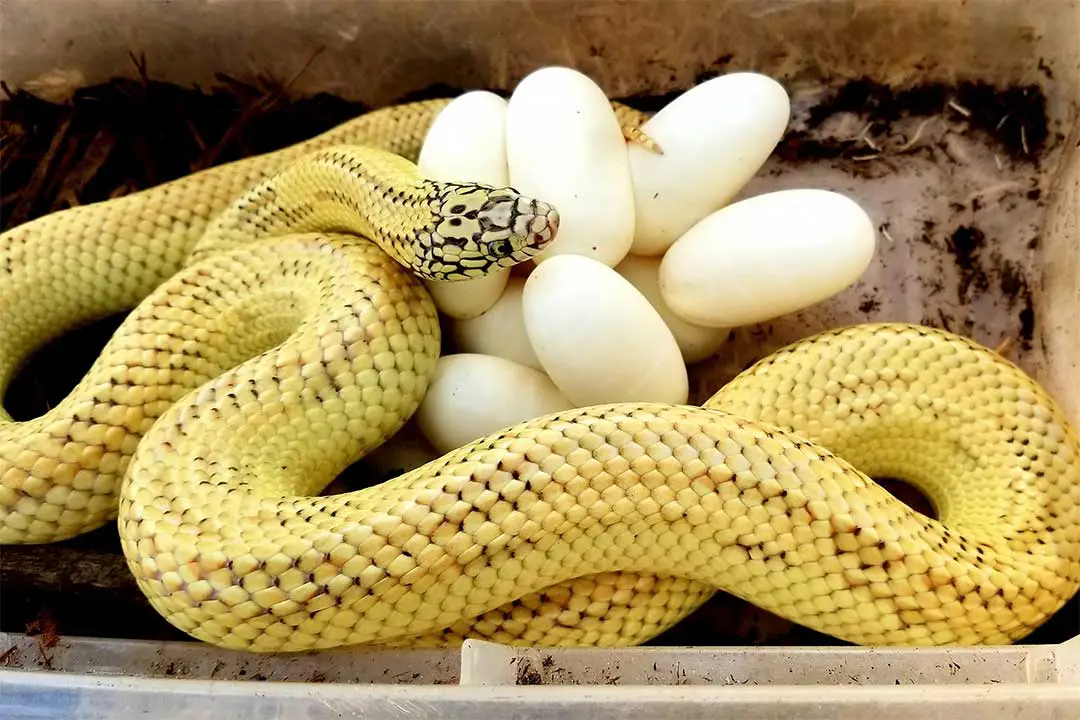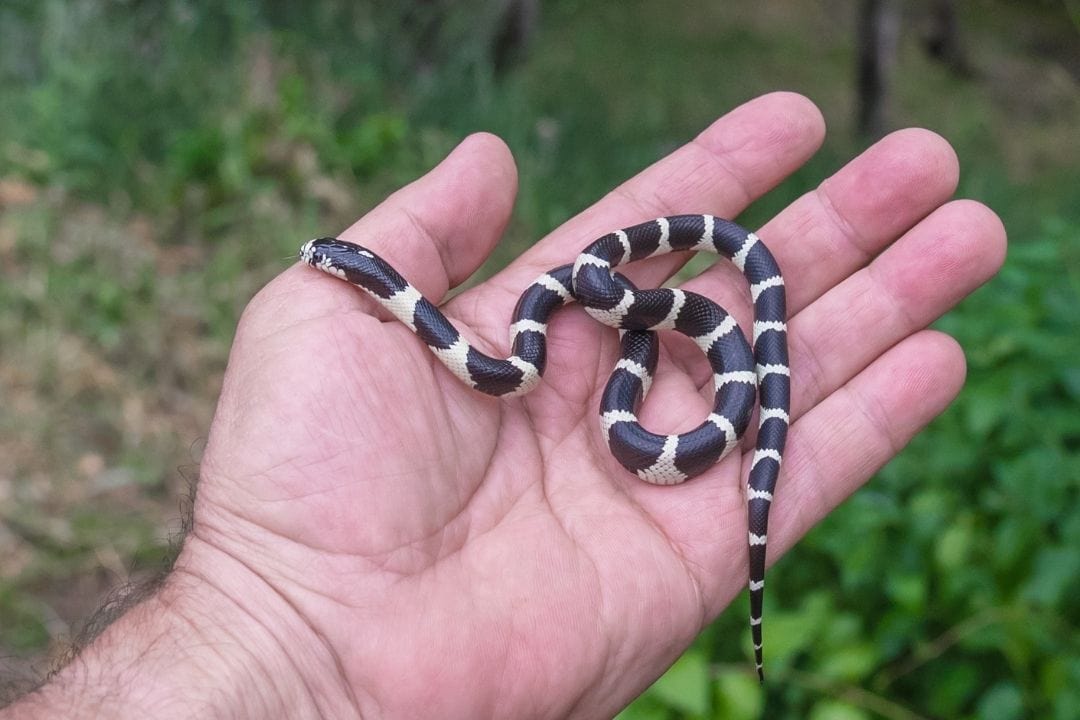King snakes make for great pets. If you want to raise any member of the Lampropeltis genus, let this be a quick start.
The California kingsnake Lampropeltis Californiae is the most common species in captivity, so this guide primarily focuses on them.
However, most king snake species and morphs have similar care needs. The main difference might be more humidity for the Florida kingsnake or the size difference of the Scarlet kingsnake.
Kingsnakes are found all over North America, in nearly every type of habitat. Look into your specific species for ideas on how to refine care for them.
Remember, your goal is to mimic the natural habitat and allow your snake to exhibit natural behaviors.
King Snake Enclosure
The most important factor for your snake is how you house it. We will go over how to create the perfect home for your snake.
The enclosure is the first thing you need to acquire for your snake.
Glass is the most common and easily cleaned material for terrariums. You can also find wood enclosures, these retain heat well and look nice in the home. Plastic also works, but it can be damaged easily during cleaning if you aren’t careful.
Remember to make sure any enclosure you choose can maintain temperature and humidity and keep your snake inside. Kingsnakes are gifted escape artists, so you need a secure enclosure. Side-entry enclosures tend to be the most secure. An aquarium with a screen lid can work, but kingsnakes are very strong and may push it open.
Remember that kingsnakes need enough space to fully stretch out and enough room to explore. A longer terrarium is better than a tall one, partly so you can maintain a temperature gradient. You do need some height, so your snake can climb. Kingsnakes love to climb in the wild.
Hatchling and Juvenile Enclosures
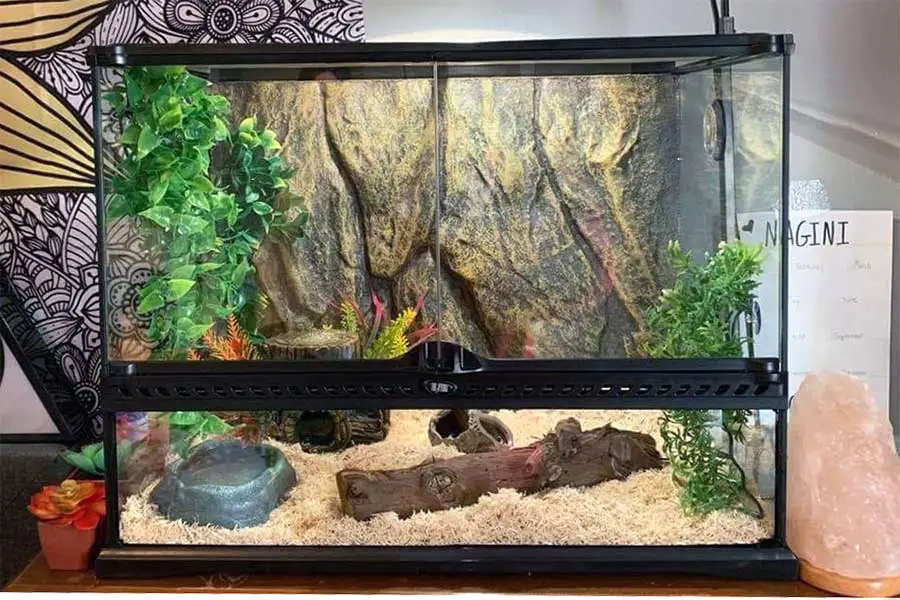
For a juvenile snake, you want an enclosure that allows you to access your snake from the side. Young kingsnakes are nervous and flighty, and approaching them from above will frighten them.
Most kingsnakes hatch at a length between 8 and 12 inches. This means that a smaller enclosure is fine for a hatchling.
Once the snake reaches twice the length of its enclosure, you need to upgrade it.
The terrarium above is a good example of a juvenile kingsnake enclosure. It has good ventilation, side-opening doors, locks, and easy access to heating.
You can keep a young kingsnake in an adult-sized terrarium if you want. You just need to have plenty of hides and fill all the space. Open space is stressful for kingsnakes.
Enclosure for adult king snakes
The adult enclosure will depend on how large your kingsnake is. The average California kingsnake is 3-4 feet n length, though some individuals will top 5 feet in length.
Scarlet kingsnakes are only about half the size. You should give the longest enclosure you can fit. It needs to be at least long enough for your snake to stretch out fully.
You should also make sure all the hides and other furniture will fit. This includes a large water dish for your snake. This is a good enclosure for most kingsnake species.
It has plenty of ventilation, you can easily run the under-tank heaters, and it is secure. Being able to handle your snake from the side is also good. Remember, kingsnakes are very powerful and will try to escape.
You need a secure tank or you will have a reptilian disappearing act.
Substrate
A substrate is needed both for cleaning and for your snake’s comfort. You can use something like paper or reptile carpet, but this doesn’t allow for natural burrowing behavior.
These are easy to clean, but frequently best for quarantine or for young snakes so you can monitor their health. Just remember to never use any paper with ink on it. A particulate substrate like wood shavings, pelleted paper, or soil meant for reptiles is all good since they allow burrowing behavior.
You need to layer these at least 3 inches deep so your snake can dig. Watch for humidity as well, since some substrates hold the humidity better. Make sure you don’t use any aromatic wood since this can cause respiratory issues in kingsnakes.
Aspen bedding for reptiles is a good choice if you want something easy. Remember to spot clean for urine and feces regularly. Always replace the removed substrate.
Heating
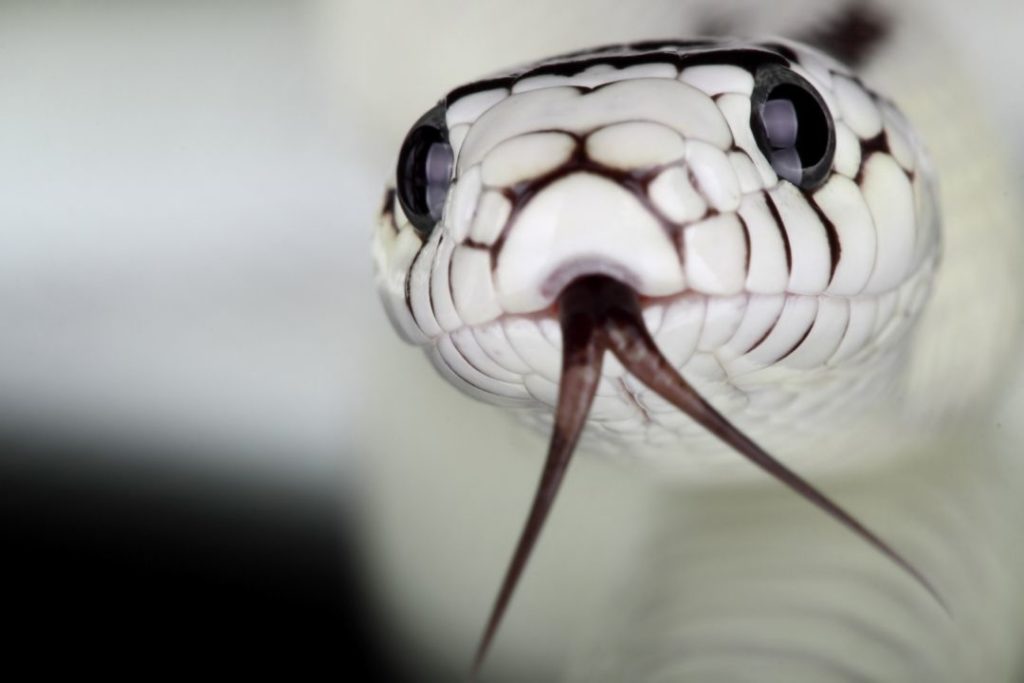
Kingsnakes are ectotherms, meaning they require outside heat to raise their internal temperature. You will need to provide a source of heat on one end of your enclosure and let the other end remain cooler.
This allows your snake to move throughout the enclosure to regulate its temperature.
Proper temperature gradient for a king snake
You should aim for 85 degrees on the warm side and around 75 on the cool. Use a thermometer to check, and keep a temperature gun to make sure what the floor of the enclosure is at.
A heat mat under the tank hooked up to a thermostat at one end of the tank will help keep your snake warm enough. A heat lamp isn’t needed unless you are dealing with a very cold home.
Heat lamps can dry out the tank too much and cause shedding problems. They also may only warm the air and leave the floor too cold for your snake.
Lighting
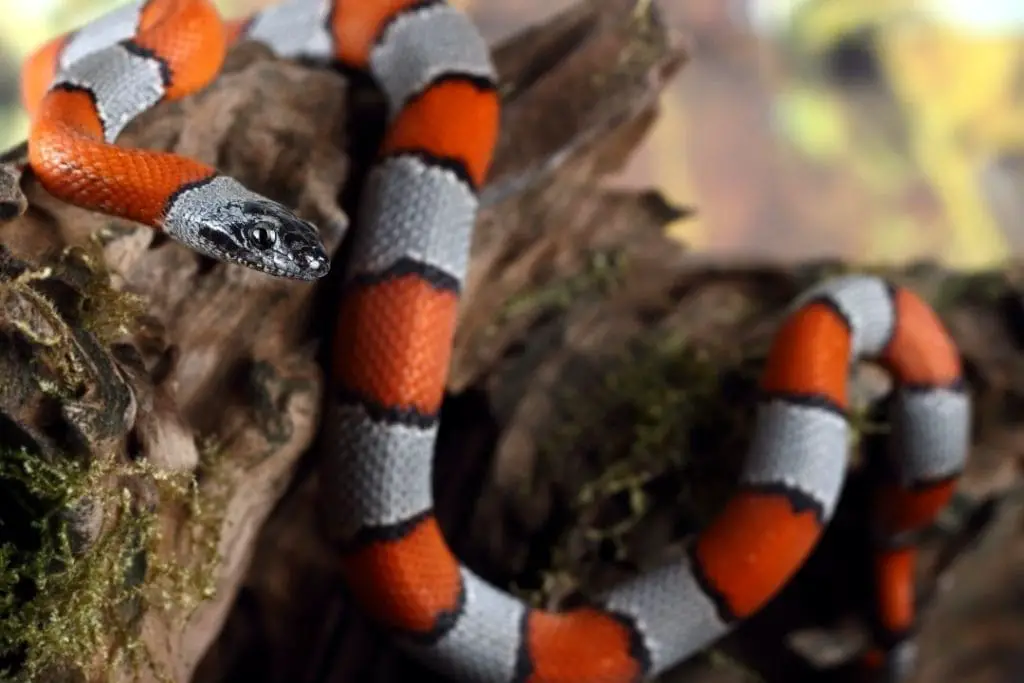
Kingsnakes do not need special lighting. If they are in a room with natural light, they should be fine.
Just keep away from windows since the cage may get too hot. You can use a basking light or other lighting for aesthetic reasons.
Shelter
Kingsnakes need shelter to feel secure. They naturally avoid open space since their main predators are birds of prey. In captivity, you need to provide shelter.
It needs to be large enough for the whole snake to fit without leaving too much extra space.
You should look for something that is easy to clean or that you don’t mind throwing out every year.
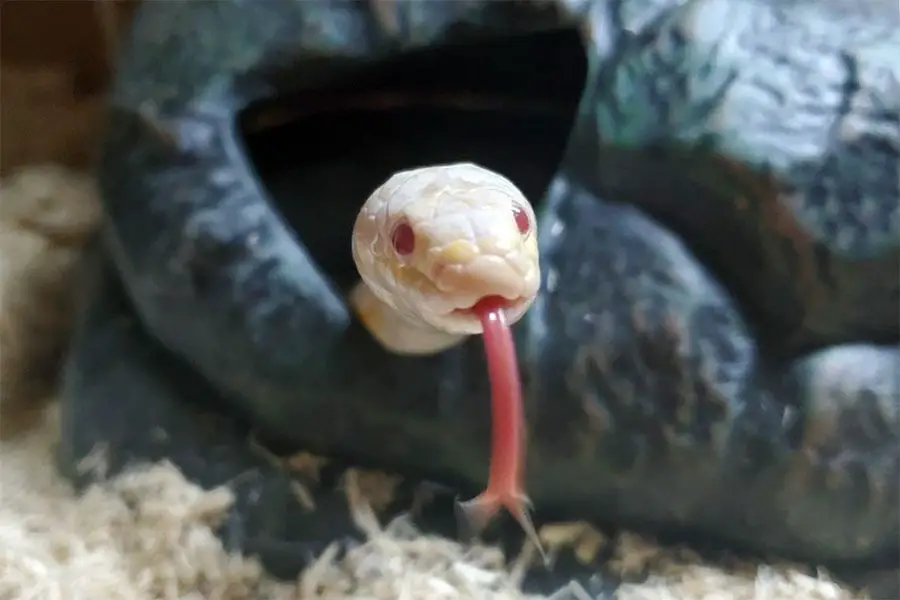
If you are using a substrate that allows burrowing, placing some pieces of bark can provide an extra hide. You need at least one hide on each side of the enclosure with a few bonus hides if you can fit them.
The repile cave above is a good example of a hide. This one is also nice since you can place moss inside to make a damp hide when your snake is preparing to shed. If this is too small, look for something similar.
Water
Snakes require access to fresh water at all times. You need something that can be cleaned easily and can’t be tipped over. It should also be large enough to allow your snake to soak its whole body if it wants.
Many king snakes will want to soak when they are close to shedding. Remember to change the water at least every 2 days. You will also want to sanitize the bowl regularly.
Humidity
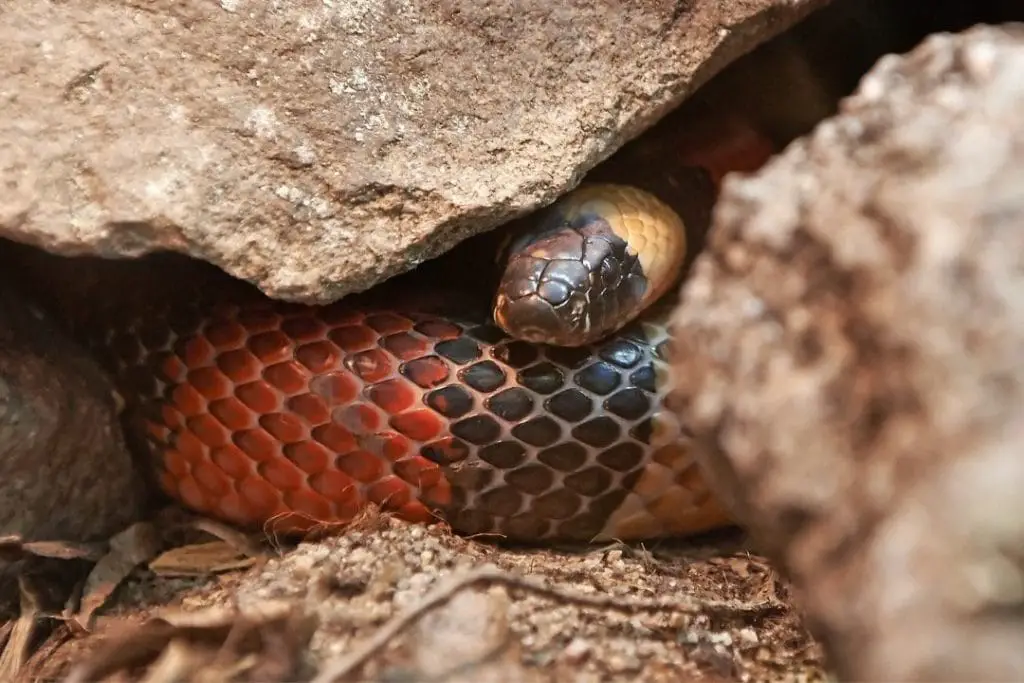
Your snake will need a minimum humidity level of 40-60% to successfully shed. You should keep it at this level at all times since low humidity can also make your snake more likely to dehydrate.
You should install a hygrometer and mist the tank if it gets too low. Damp moss can help your snake shed if it is placed in the hide on the warm side.
Enclosure Maintenance
Your king snake needs to be kept in a clean enclosure to avoid illness and infections. You should start by checking the water, temperature, humidity, and spot clean any urine or feces daily.
Every two days you should give your snake fresh water. You should do a full clean at least once a month. This means removing your snake to a temporary container while you clean its home.
A plastic tote with air holes is sufficient to hold your snake for the time it takes to clean.
After your snake is out, the first step is to remove all the decorations and turn off the heating units. You need to remove all the substrate and scrub the enclosure down to remove any waste or dirt.
You should also use a reptile-safe sanitizing solution. Make sure you don’t spray cold liquid on hot glass.
This can cause cracking. Once you have it all scrubbed, leave the tank open to dry. Next, clean and sanitize the water dish as well as all hides and decorations.
Make sure you don’t use any cleaners that are scented or that will damage any of the decorations. Scratches can give a place for bacteria to hide and make future cleaning more difficult.
Once everything is sparkling clean, leave it to dry and add substrate to the clean and dry enclosure. Replace all the decorations and the water dish. Now you can return your snake to its home and plug the heating back in.
Feeding
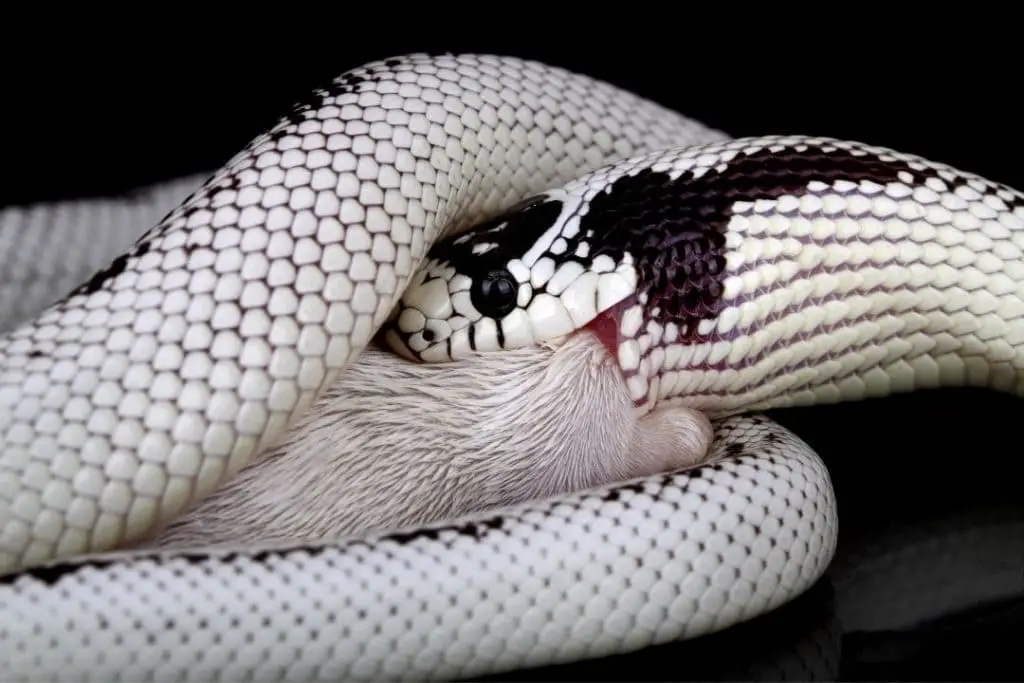
Food is important for your snake. Kingsnakes have a wide diet in the wild.
They will eat pretty much anything they can overpower. This includes rodents, amphibians, birds, and reptiles.
The king part of their name refers to their fondness for eating other snakes. This even includes venomous snakes like rattlesnakes. Remember to never house other reptiles with king snakes, since they will likely try to eat them.
Type and Size of Prey
In captivity, king snakes are typically fed mice and other rodents. The size of the prey should be just about the width of the snake.
When it has eaten, you should see a small lump midway down the snake’s body. Hatchlings eat pinky mice and move up to larger mice as they age.
Never feed anything larger than 1.5 times the widest part of the snake. You can go by weight for feeding. Weigh your snake in grams and feed about 10-15% of your snake’s body weight.
Once your snake reaches adulthood, feed enough to maintain body weight and condition. You can also feed reptiles or amphibians to your snake, or opt for the reptile sausages known as ReptiLinks if you want your snake to have more food options.
Kingsnakes tend to be voracious eaters, so you might have luck offering them after scenting the link with a mouse or other appealing prey.
Live vs Frozen

The frozen vs live debate is a strong one among reptile owners. Let’s go over the pros and cons quickly.
Live Food Pros:
- Allows more natural behaviors
- Slightly more nutrition
- Snakes will be less likely to refuse food
Live Food Cons:
- Have to keep live rodents around
- More expensive
- Can injure or kill your snake
- Can give your snake parasites
- Cruel to the mouse
- Can’t buy online
Frozen Food Pros:
- Easy to keep on hand
- Cheaper to buy in bulk
- Convenient for owners
- Can’t harm your snake
- Know the mouse was killed humanely
- Easy to find online
Frozen Food Cons:
- Slightly less nutritious
- Snakes may refuse it
- Need to defrost it properly or you can make your snake ill
For live mice, you should never leave your snake alone until the mouse is dead. You don’t want to risk the mouse harming your snake. If you feed frozen, you need to defrost it properly.
This is much like defrosting meat for your own use. You should put a mouse in the fridge a day before you want to feed your snake. T
hen, place in a BPA-free plastic bag and immerse in warm water until the mouse reaches body temperature. This is around 100 degrees for a mouse.
Then you can feed your snake. Offer it in a separate feeding container so your snake doesn’t ingest any substrate.
As for buying, you have more options with frozen mice. It isn’t legal to ship feeder mice, so you need to find a local source for live feeders. Some reptile keepers will breed mice for their pets, so you may be able to find them locally on Facebook or Craiglist.
You can also check local reptile or pet shops for feeder mice in the right sizes, or visit a reptile show.
Frozen mice can be shipped, and can be bought online as well as at pet stores or reptile shows.
Perfect Prey, Rodent Pro, Big Cheese Rodents, and Layne Labs all offer frozen mice in bulk and in a variety of sizes. This can be a good way to stock up on food.
Micedirect sells on Amazon, I recommend checking them out, the packaging is great, shipping very fast and they use co2 to kill their mice instead of less human methods.
Once your king snake is an adult, you can buy bigger packages of mice and save money.
Remember to keep an eye on local stores so you can keep a stock of food for your kingsnake.
Feeding Frequency
How often to feed your snake depends on its age. For hatchlings, you should feed every 5-7 days. After a year, you can switch to 7-10 days. Adult kingsnakes eat every 10-14 days.
Watch your king snake’s weight so you know it is growing steadily or maintaining weight.
When your snake is hungry, it will hunt around its enclosure. Once you see this behavior, you should prepare to feed your snake.
Don’t offer food until your snake has digested its last meal and defecated. You also shouldn’t handle your snake for a few days after a meal to avoid regurgitation.
Shedding
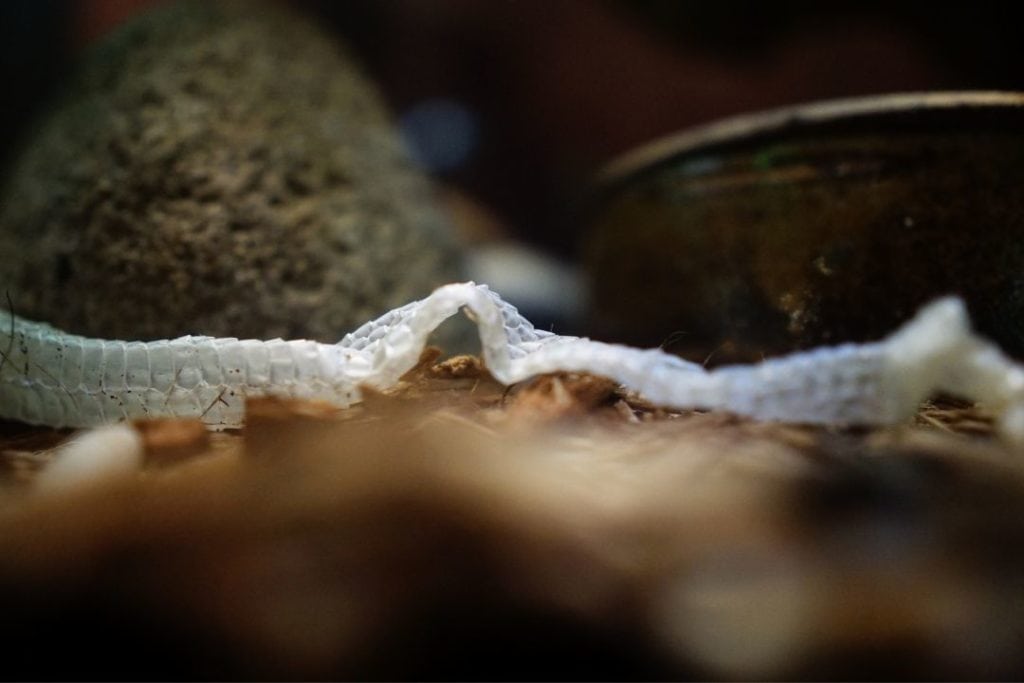
Shedding is necessary for snakes. A snake’s skin doesn’t grow like a human would, so they need to shed it to grow larger. Hatchlings shed fairly frequently, as often as every month, while adults may only shed 2-6 times a year.
This depends on how quickly it takes for the old skin to become too tight. When your snake is getting ready to shed, you will see its color dull and the eyes go opaque or blue.
Your snake can’t see well, so it will be grumpy and more likely to bite or musk you.
After a few days, the dullness will fade. You will notice your snake rubbing on the corners of the tank or decorations. Then the snake will shed its skin.
Once the snake has shed, you should check to make sure old skin is whole. Pay attention to the eyecaps and the tail tip since these are most likely to be stuck. If any part of the skin sticks and isn’t removed, it can harden and injure your snake.
This can result in infections or even the tail being amputated. You should provide a damp hide with moss on the warm side when you notice your snake beginning to shed.
If your king snake has any stuck shed, you can either offer damp moss in a hide or you can soak the snake in warm water for half an hour. Then you can try to gently remove any stuck shed with clean tweezers.
Don’t force it if it is still stuck, just repeat the soaking until you can remove it safely.
Hibernation
King snakes in the wild will undergo a process known as brumation in the winter. Colder temperatures mean the snake will find a safe place and sleep. They will wake occasionally to eat, but won’t take food.
You don’t need to induce this in captivity unless you are breeding your snakes. During winter, you may notice your snake refusing food more often or being less active. This is normal, but make sure your temperatures are still stable.
Handling
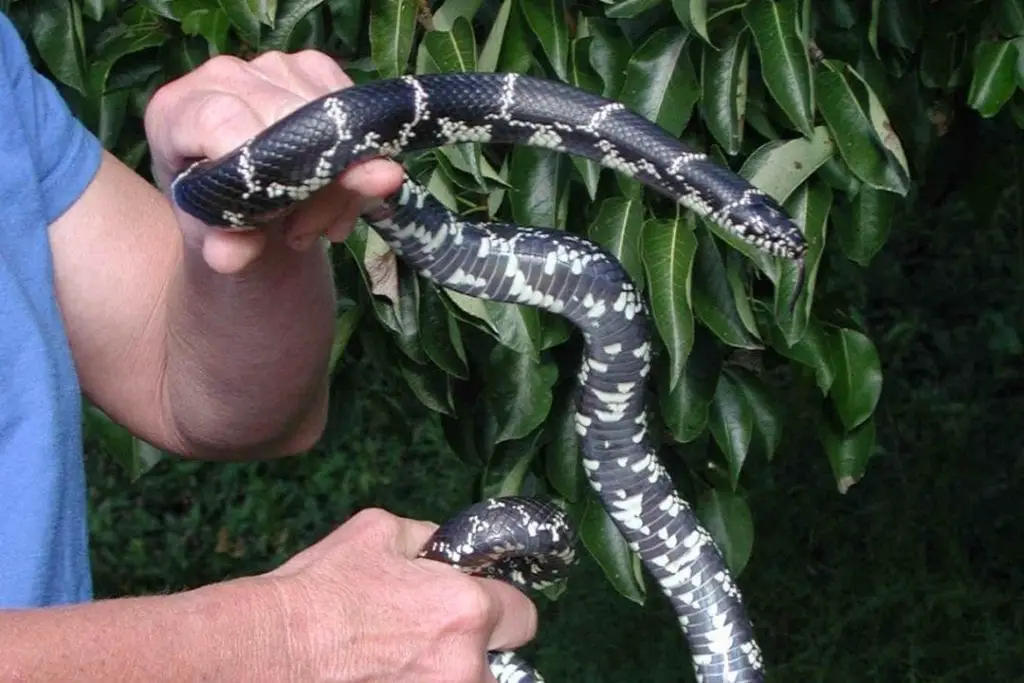
King snakes should be handled regularly so you can get them used to being handled for things like cleaning their cage or feeding. Many kingsnakes seem to enjoy handling and being allowed out of their cages.
Make sure your hands don’t smell like prey before you approach. Never approach a kingsnake from above, since this mimics a predator. Approach from the side and lift your snake from below. S
upport as much of the body as you can, but don’t restrain the snake.
Young snakes will be flighty and frightened. Be gentle and stick with short, positive handling sessions until they learn that you won’t hurt them.
Try to return your snake to its enclosure only after it calms down. You should handle it at least once a week. Never handle a snake right when it is shedding or after a feeding.
If your snake bites you, stay calm and allow it to release you. If you pull the snake off, your wound will be worse and the snake could be injured.
Common Issues
Now we will go over a few common issues with kingsnakes. Always remember to consult a qualified reptile vet if you are worried about your snake. It’s better to catch any health issues early.
My King Snake Isn’t Eating
Feeding issues can be very stressful for owners. There are a number of reasons why your snake may not be eating. The first and most common is that you are offering food too often. Snakes take longer to digest than mammals. For hatchlings, they will likely only want to eat every 5 days.
Older snakes may take up to 2 weeks to be interested in prey again. Wait for a few days and try offering a fresh piece of food. Make sure you defrosted the prey properly, and heat it up to body temperature.
Sometimes, holding the prey in feeding tongs and moving it around will make your snake strike and eat the prey.
Make sure the temperature and humidity are at the right levels. Snakes can’t digest if the temperature is too low. They will avoid food since it will rot inside the snake before the food is digested.
If the prey is too large, your snake may not want to eat it. Try a smaller prey item. Some snakes will also be picky on the color of a mouse, so try to find a different shade.
If your snake eats live food and it was bitten by a mouse, it may be reluctant to eat. Switch to frozen prey and try again. If your snake is ill, it will also not want to eat. Look for signs of infection or illness like labored breathing or excess mucus and take your snake to a vet.
If your snake is very reluctant to eat, look into offering other prey like amphibians, reptiles like lizards or snakes, or bird chicks or eggs.
Regurgitated Food
Sometimes a snake will regurgitate its food. This can be dangerous to the snake. Regurgitation can be caused by stress, illness, or the prey being too large.
Never handle your snake after a meal and make sure the prey item isn’t larger than 15% of its body weight. You should also let your snake rest and make sure all of the temperatures are in the right range with your temperature gun.
Some illnesses can cause regurgitation. This includes a parasite that will thicken the stomach lining. Make sure to get your snake to the vet if it regurgitates two prey items in a row.
The prey item may also have a parasite or be dangerous in some way. Change where you get the prey if the vet rules out other causes.
Respiratory Infections
Respiratory infections are a big problem for snakes. They can be caused both by poor conditions or sanitizing as well as high humidity. Look for mucus coming out of the mouth or nose and listen for labored breathing.
You may hear wheezing, clicking, or other strange sounds if your snake has an infection. Another sign is that the snake may switch to breathing with its mouth open.
If you notice these signs, take your snake to the vet immediately. Infections are very treatable so long as you catch them early.
Sources
https://animals.sandiegozoo.org/animals/kingsnake
http://www.californiaherps.com/snakes/pages/l.californiae.html
How snakes eat snakes: the biomechanical challenges of ophiophagy for the California kingsnake
https://srelherp.uga.edu/snakes/lamget.htm
https://www.floridamuseum.ufl.edu/florida-snake-id/snake/florida-kingsnake/
Conclusion
Now you know everything you need to know to keep your new kingsnake healthy. If you care for your snake well, it may be with you for 20 years. If you have any questions or comments, please leave them below.
